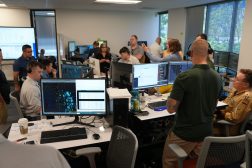‘We can go faster’ on EW reprogramming, Air Force spectrum warfare commander believes

This is part two of a two-part series exploring how the Air Force is looking to modernize and reinvigorate electronic warfare within its capability portfolio. Part one can be found here.
NATIONAL HARBOR, Md. — The new commander of the Air Force’s electronic reprogramming wing wants his personnel to be able to send fixes back to operational forces less than three hours after problems are discovered.
In the cat-and-mouse game of electronic warfare and electromagnetic spectrum operations — where adversaries seek to deny access to the spectrum for communications or navigation through jamming — agility and speed are paramount. Once a signal is detected, forces must work to reprogram systems to counter it, which during the Cold War could take weeks to months as the signal had to be sent back to a lab, a fix devised, and then sent back to the field.
In the modern digital world, forces are looking to reprogram systems in as near real-time as possible to stay ahead of threats.
Previous commanders of the Air Force’s 350th Spectrum Warfare Wing have described a “moonshot” of trying to send updates back to the field in three hours for prioritized threats. However, the current commander is even more ambitious.
“That’s not fast enough for me. I want to see where we can create efficiencies as we go through the process, we institute and put in new technologies that can make us go faster — whether it’s machine learning or AI that can help us bring that data from the forward edge, bring it back to our analysts so they can do the analysis as well as the exploitation of it, and get that information pushed back out to warfighters as fast as possible,” Col. Larry Fenner, who has been the commander of the 350th for about two months now, said in an interview at AFA’s Air, Space and Cyber conference last week.
“I’m not going to put a [specific goal] number out there, because it makes people think, ‘Hey, if I met that number, I’m good.’ I was like, ‘No, you need to go to speed of relevance for the warfighter because that’s the scenario we’re dealing with.’ I want to outpace my adversary in all aspects,” he added.
The 350th Spectrum Warfare Wing was born in 2021 as a direct result of a landmark study over six years ago known as the Enterprise Capability Collaboration Team that sought to dive deeper into electromagnetic spectrum issues and develop institutional changes.
Of the three reforms the study recommended was the need to consolidate the Air Force’s reprogramming enterprise into a single entity because it was too spread out across several organizations.
The wing is focused on three missions: rapid reprogramming, target and waveform development, and assessment of Air Force EW capabilities.
Fenner also noted that in another departure from past visions of the wing’s operations, he is now starting to rethink the notion that reprogrammers will remain at static locations in the continental United States.
“That is something we’re thinking about because we understand, when you deal with agile combat employment and how we’re going to fight to deal with the pacing challenge [of China], you have to be dynamic,” he said. “You’re going to have to have folks that are in the right places to make sure that the data continues to flow, because I will tell you that’s the key data is the weapon. If the data stops, then we’re not being able to update the warfighters with the most relevant and pertinent data that is out there to make sure that they are able to detect and recognize those threats. If it’s the people that are at the spokes or at the hubs or these different locations where they need to be to make sure that the data does not stop, we will do what we need to do to make sure that those folks are in place.”
Fenner wants to eventually be able to take advantage of machine efficiencies to remove some people from workflows in order to allow that data to be pulled off an aircraft, flowed to the reprogrammers, analyzed, exploited and pushed back at machine speed, which will reduce the manpower footprint and enable units to act faster against threats.
Speed will be impacted by data transport and bandwidth, which surely will be limited by adversaries in future fights. But, Fenner acknowledged, officials are already looking at the data and transport architectures of the future to be able to make the process go faster.
“We believe we can go faster and the warfighter absolutely needs us to go faster because they do not want to go out there and not have the ability to know what’s out here and to be able to respond,” he said.
The wing has been very busy testing its wares in exercises, which are critically important given the unit is so new.
The organization has worked to test not only frameworks for data flows, but how it can improve its tactics and relationships with operational forces.
The first internal exercise the wing established was Rapid Raven, a necessity to begin to establish a baseline to understand what it was capable of and how fast it could reprogram.
“My predecessor, he established [Rapid Raven]. He’s like, ‘Look, I need to know, can we meet the operational pace of the warfighting scenario?’ What I will tell you is, what we found out [is that] we can go pretty fast,” Fenner said. “We’ve been so used to an institutionalized, normal, annual program of pushing [mission data files] out. But when we say, ‘Hey, we’re going to snap the line and we’re going to go in crisis mode, how fast can you go?’ — surprisingly, we can go pretty fast. But I’m never satisfied. As we reoptimize for great power competition, I think we can go faster.”
The wing then put its capabilities to the test in Bamboo Eagle, a new exercise this year established by the Air Force Warfare Center. Few details have been released publicly about the exercise as it has been highly sensitive. What’s known about the effort is it’s aimed at testing the service’s agile combat employment concept against a China threat, focusing on things like distributed command-and-control and disaggregated mission generation. It differs from the Air Force’s premier Red Flag exercise by exposing the entire friendly kill chain — including things like logisticians loading pallets — to enemy threats, as opposed to just exposing operators to adversaries’ tactics, officials have said.
Fenner said it was critical to see how his force stacks up against a simulated China threat under the agile combat employment model.
“Are we actually training like we fight and where can we improve and get better? Is it in a live-virtual construct? Highlighting that to senior echelons so now they know, hey, here are the things that we need to invest in, here’s where we need to go to make those capabilities better so that hard warfighters truly do train like they fight,” he said.
Enter the newly established 950th Spectrum Warfare Group, for which the assumption of command will take place next month. The 950th will be focused on combat electronic warfare assessments, with subordinate units having already stood up a year ago as the precursor to the group.
The organization “is going to be an absolute boon for the 350th Spectrum Warfare Wing, because it’s going to allow us to get the truth gap. Where are we lacking, where we are currently and where we need to go,” Fenner said, noting the group will be providing self-scouting for the wing. “It’s not enough to just tell [the team], ‘Yep, we’re not doing good or we’re doing great.’ Where can we improve? Because it should be an inner process, ‘Hey, I’ve assessed our systems, here’s where the current state is, here’s where we see where we can improve,’ whether it’s new equipment, maybe it’s human factors, things that we may need better training on — or is the system getting old and now we need something newer? They will inform those gaps and seams that we have within our own equipment, within our own processes.”






